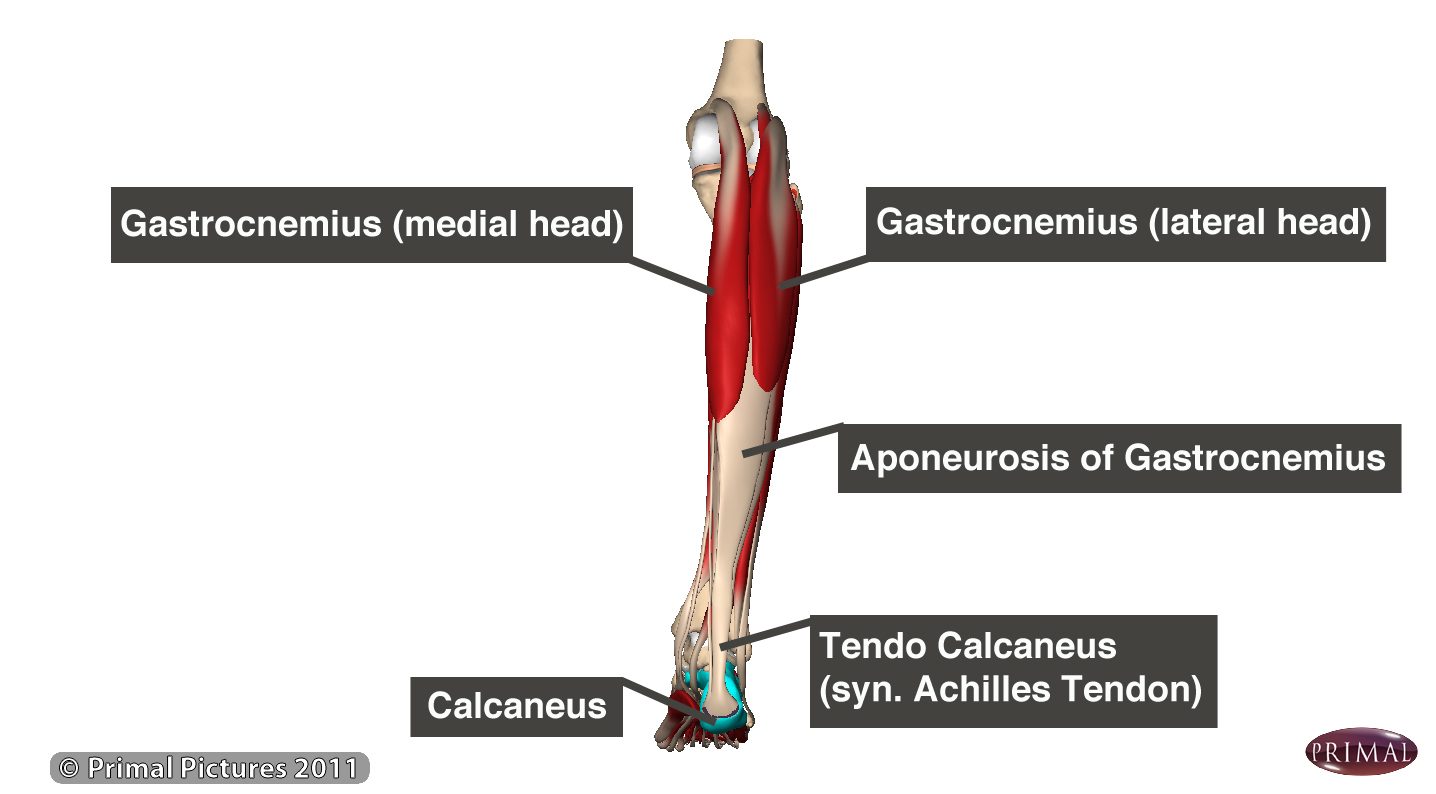
The calf muscle is found at the back of the lower leg and is comprised of three muscles: the plantaris, the gastrocnemius and the soleus. These 3 muscles are referred to as ‘the triceps surae’, and they attach to the Achilles tendon.
They are responsible for extending the foot (plantar flexion) and bending the leg at the knee joint.

The Achilles tendon attaches to the heel bone (the calcaneus). The soleus sits deep to the gastrocnemius, with the plantaris muscle and part of its tendon located between these two muscles.

A calf strain occurs as a result of these muscles being torn or pulled. When a muscle is stretched, small micro tears occur in the muscle fibres. The severity of these tears depends on the depth and suddenness of the stretch. There are three different degrees of calf strain: grade 1 is a mild strain, grade 2 moderate to severe pain and a grade 3 strain is a complete rupture.
What Causes a Calf Strain?
A calf strain occurs when the calf muscles are over stretched. This can be caused by a sudden, abrupt movement or as a result of over use.
- Insufficient warm up or cool down is a common cause of calf strain.
- A sudden change of direction.
- Explosive movement or increase in speed can result in the calf muscles becoming torn or strained.
- Climbing or running up hills.
- Over pronation.
- Wearing inappropriate footwear.

What are the Symptoms of a Calf Strain
- A sudden sharp pain in the lower leg.
- Pain/ache in the calf, usually mid calf.
- Pain on resisted plantar flexion (pointed toe) or when standing on pointed toes.
- A sensation of being hit on the back of the lower leg.
- A burning/stabbing sensation.
- Inflammation of the lower leg.
- A lump can be felt.
- Bruising to the lower leg, as a result of internal bleeding.
- Difficulty weight bearing.
- Tightness

Calf strains can normally be catagorised into 3 grades.
Grade 1 degree strain Symptoms:
- Slight swelling and bruising.
- The muscles can feel tight and ache when stretched.
- Pain/discomfort can be felt after the activity, and can last from between 2-5 days
Grade 2 degree strain Symptoms:
- The pain is immediate.
- The muscle can be tender to touch.
- There is inflammation.
- A few days after the injury, bruising will appear below where the partial tear has occurred.
- The muscle feels tight and painful on resisted plantar flexion (pointing the toe).
Grade 3 degree strain Symptoms – a complete rupture
- Pain is felt immediately, and can feel like a burning or stabbing sensation.
- The muscle is tender to touch.
- Inflammation occurs.
- A lump of muscle tissue can be felt where the tear has occurred.
- A few days after the injury, bruising will appear below where the rupture has occurred.
- Pain is felt when walking or weight bearing.
- Unable to contract the muscle, as the muscle has ruptured completely.
Calf Strain Treatment
It is important not to ignore a calf strain, as this could cause further damage and lead to a grade 3 strain. The earlier the treatment, the better the outcome. In a grade 1 strain recovery is roughly 2 weeks. In a grade 2 strain, recovery can take up to 5-8 weeks, and for grade 3 strains can take up to 3-4 months.
Rest: to prevent further damage.
In the sub acute (3 days to 3 weeks) and the chronic stage (3 weeks to 2 years) it is important that training should be adapted to avoid jumping or any exercises that put excessive strain on the gastrocnemius or soleus.
A physiotherapist or sportsmassage therapist or sports therapist can advise when exercise should be resumed and what exercise would be appropriate.
Ice treatment: Ice, can be applied for 10-15 minutes, every 2-3 hours in the acute and sub- acute stage (frequency can be reduced according to recovery, and can be continued for as long as deemed necessary). Ice bands are an effective way of applying ice therapy. In the sub-acute stage (3days – 3 weeks) heat therapy can be applied.
A doctor or physiotherapist might recommend an MRI scan to assess the extent of rupture. In severe cases surgery might be performed.
A physiotherapist might prescribe ultrasound treatment, sound waves; which speeds up the repair process, by breaking down tissues and stretching them. It can also help alleviate pain.
Massage can help aid recovery, and improve joint mobility and range of movement. It should not be administered during the acute stage. If there is any underlying medical condition, such as a heart condition, it is important to seek medical advice before receiving massage.
A physiotherapist or sports massage therapist can recommend strengthening, flexibility and proprioceptive exercises in the sub-acute and the chronic stage of recovery. Exercises should focus on stretching and strengthening, focusing on the gastrocnemius and soleus muscles; for example calf and toe raises. The intensity of the exercises should be increased gradually and in a controlled way. Resistance bands are good for gentle stretching.
For injury prevention, it is essential that a warm up and cool down forms part of an exercise programme (10-20 minutes, depending on the duration of the programme).
For further information about calf strain, please follow this link.

